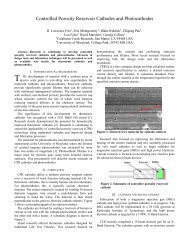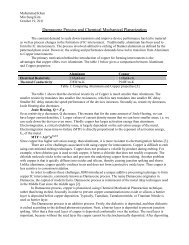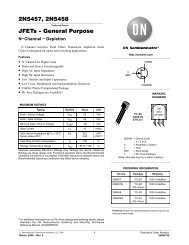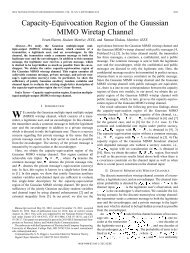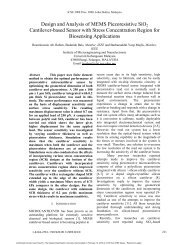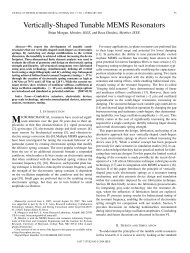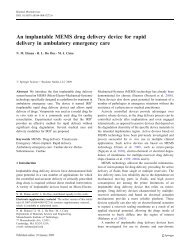A BioMEMS Review: MEMS Technology for Physiologically - ECE ...
A BioMEMS Review: MEMS Technology for Physiologically - ECE ...
A BioMEMS Review: MEMS Technology for Physiologically - ECE ...
Create successful ePaper yourself
Turn your PDF publications into a flip-book with our unique Google optimized e-Paper software.
in which features unique to <strong>MEMS</strong>, such as optical and<br />
electrical sensitivity or feature size comparable to relevant<br />
biological structures, are being leveraged <strong>for</strong> maximum<br />
impact.<br />
The digital capabilities of <strong>MEMS</strong> may allow potentially<br />
greater temporal control in the area of drug delivery than<br />
can currently be achieved with polymer-based systems.<br />
Additionally, the incorporation of optical, electrical, or<br />
chemical sensing components into <strong>MEMS</strong> devices can<br />
allow the delivery of drugs to be attuned to changes in<br />
the physiological environment surrounding the device. A<br />
number of researchers have pursued a similar strategy <strong>for</strong><br />
the incorporation of sensing components into responsive<br />
polymeric systems <strong>for</strong> drug delivery, including systems<br />
that can be triggered by the application of ultrasound [5],<br />
[6], changes in pH [7]–[12], temperature [13]–[18], analyte<br />
concentrations [19]–[21], and electric [22]–[27] or magnetic<br />
[28], [29] fields. While these systems are useful and interesting<br />
in their own right, we will not discuss them in detail,<br />
as they largely fall outside the scope of this paper.<br />
The small size of <strong>MEMS</strong>, coupled with their ability to<br />
achieve precise control over the timing of drug delivery, may<br />
prove to be of great utility in the area of actuation of physiological<br />
systems within the human body. Molecules such as<br />
hormones or growth factors are often quite potent, and their<br />
effect is strongly influenced by their temporal administration.<br />
These potent molecules affect signaling and regulatory<br />
systems in the body, such as the endocrine and nervous systems.<br />
The ability of <strong>MEMS</strong> to act on a short time scale and<br />
under physiologically relevant conditions, coupled with their<br />
ability to deliver an electrical stimulus and/or drugs from a<br />
device, offer the potential <strong>for</strong> these devices to actuate systems<br />
in the body.<br />
We focus in this paper on the idea of physiological integration<br />
of <strong>MEMS</strong>, which encompasses two main concepts.<br />
First, we will examine how the physiological integration<br />
of <strong>MEMS</strong> and other implantable devices can be improved<br />
through the application of microfabrication technology and<br />
concepts, and we review the current state of the art in the<br />
assessment and improvement of <strong>MEMS</strong> biocompatibility. In<br />
some cases, such as the microtexturing of surfaces <strong>for</strong> better<br />
cell adhesion, greater physical integration of the device can<br />
be achieved with the in vivo environment. In other cases,<br />
the chemical interaction between the device and biological<br />
environment can be improved, such as through the surface<br />
functionalization of devices with protein-resistant moieties,<br />
or alternatively the patterning of cell-adhesive molecules.<br />
Second, we will present a new perspective on the ability of<br />
<strong>MEMS</strong> to actuate various systems within the body, taking<br />
as our example pacemakers and cardiology devices. We<br />
suggest that the application of <strong>MEMS</strong> and microfabrication<br />
technology may enable better logistical and physiological<br />
integration with the delicate systems of the human body than<br />
is currently available in clinical or commercial treatments,<br />
such as <strong>for</strong> actuation of the endocrine system. One can envision<br />
the utility of <strong>MEMS</strong> as a uniquely powerful plat<strong>for</strong>m<br />
<strong>for</strong> delivering potent therapeutic agents whose temporal<br />
administration is vital to their efficacy, and whose effect is<br />
naturally amplified by the human body.<br />
II. IMPLANTABLE <strong>MEMS</strong><br />
A variety of implantable electronic devices are based upon<br />
or use <strong>MEMS</strong> technology, including sensors, immunoisolation<br />
capsules, and drug delivery microchips. These topics, as<br />
well as a novel application of microfabrication technology to<br />
stents, are briefly reviewed here.<br />
A. Biosensors<br />
Much has been done in the application of <strong>MEMS</strong> technology<br />
to biosensors and the adaptation of various types of<br />
sensors to in vivo diagnostics. However, at the intersection<br />
of these fields, namely, implantable <strong>MEMS</strong> biosensors,<br />
there are few examples. This is due in part to the <strong>for</strong>midable<br />
challenges faced in the more general field of implantable<br />
biosensors. The goal of short-term sensing of pH, analytes,<br />
and pressure in blood, tissue, and body fluids has largely<br />
been achieved, but stable sensors <strong>for</strong> long-term implantation<br />
continue to elude researchers [30]–[34]. Long-term in vivo<br />
sensing is a critical component of the ideal closed-loop drug<br />
delivery or monitoring system, but the issue of implant biocompatibility<br />
and biofouling must be addressed in order to<br />
achieve long-term in vivo sensing. Although it is important<br />
to avoid adverse tissue responses to any implant, the degree<br />
of biocompatibility must be greater <strong>for</strong> a sensor.<br />
Even those materials generally considered to be biocompatible<br />
produce some degree of tissue response, usually<br />
resulting in the partial isolation of the implant from the body.<br />
Although this typically does not impede the function of drug<br />
delivery, orthopedic, or other implants whose function is<br />
essentially mechanical in nature, implant isolation leads to<br />
reduced sensitivity and increased delay time <strong>for</strong> a sensor.<br />
The same biocompatibility challenge must be overcome<br />
by any <strong>MEMS</strong> biosensor <strong>for</strong> in vivo use, as the intimate<br />
interaction of sensor and analyte is intrinsic to the operation<br />
of all sensors. Ef<strong>for</strong>ts are under way to use microfabricated<br />
biosensors in vivo, especially <strong>for</strong> the less problematic<br />
short-term sensing applications. Sensing strategies <strong>for</strong><br />
biosensors include optical [35], mechanical [36], magnetic<br />
[37], and electrochemical [38], [39] detection methods,<br />
as well as combinations of the above. For example, both<br />
optical and electrochemical sensors have been developed<br />
to monitor local pH in brain tissue and in blood [40], [41].<br />
A multiparameter sensor has been reported that combines<br />
electrochemical and fiber-optic technology <strong>for</strong> continuous<br />
in vivo measurement of pH, carbon dioxide partial pressure,<br />
oxygen partial pressure, and oxygen saturation early in<br />
human pregnancy [42]. These examples illustrate how<br />
certain features of <strong>MEMS</strong>, in this case their ability to<br />
operate in both an optical and electrochemical manner, can<br />
be leveraged <strong>for</strong> broad utility.<br />
Microfabricated pressure sensors also have the potential<br />
<strong>for</strong> in vivo application. A capacitance-based pressure sensor<br />
can be microfabricated with a membrane that de<strong>for</strong>ms according<br />
to pressure difference, causing a change in capacitance<br />
between the membrane and an electrode on the surface<br />
of the device. One such capacitance-based pressure sensor<br />
has been tested in vitro on a silastic tube made to mimic a<br />
GRAYSON et al.: A BIO<strong>MEMS</strong> REVIEW: <strong>MEMS</strong> TECHNOLOGY FOR PHYSIOLOGICALLY INTEGRATED DEVICES 7<br />
Authorized licensed use limited to: University of Maryland College Park. Downloaded on February 8, 2009 at 16:17 from IEEE Xplore. Restrictions apply.



